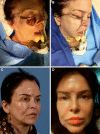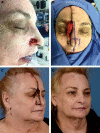Treatment of Non-melanoma Skin Cancers in the Absence of Mohs Micrographic Surgery
- PMID: 33425610
- PMCID: PMC7787325
- DOI: 10.1097/GOX.0000000000003300
Treatment of Non-melanoma Skin Cancers in the Absence of Mohs Micrographic Surgery
Abstract
Non-melanoma skin cancers are the most common malignancies globally. Although non-melanoma skin cancers exhibit low metastatic potential, they can be locally destructive, necessitating complex excisions and reconstructions. Mohs micrographic surgery is the gold-standard treatment for high-risk non-melanoma skin cancers in patients who are appropriate surgical candidates. Despite its efficacy, Mohs micrographic surgery is not readily available in most geographic regions, necessitating that plastic surgeons be well-versed in alternative treatment modalities for non-melanoma skin cancer. Herein, we will discuss the management of non-melanoma skin cancers in settings where Mohs micrographic surgery is not readily available.
Copyright © 2020 The Authors. Published by Wolters Kluwer Health, Inc. on behalf of The American Society of Plastic Surgeons.
Conflict of interest statement
Figures





Similar articles
-
Mohs micrographic surgery: a treatment method for many non-melanocytic skin cancers.Dermatol Online J. 2020 Apr 15;26(4):13030/qt8zr4f9n4. Dermatol Online J. 2020. PMID: 32621679
-
Mohs micrographic surgery: a review of indications, technique, outcomes, and considerations.An Bras Dermatol. 2021 May-Jun;96(3):263-277. doi: 10.1016/j.abd.2020.10.004. Epub 2021 Mar 24. An Bras Dermatol. 2021. PMID: 33849752 Free PMC article. Review.
-
Immunohistochemistry in mohs micrographic surgery: a review of the literature.J Clin Aesthet Dermatol. 2009 Jul;2(7):37-42. J Clin Aesthet Dermatol. 2009. PMID: 20729969 Free PMC article.
-
Mohs micrographic surgery for the treatment of primary cutaneous melanoma.J Am Acad Dermatol. 1997 Aug;37(2 Pt 1):236-45. doi: 10.1016/s0190-9622(97)80131-4. J Am Acad Dermatol. 1997. PMID: 9270510
-
Mohs Micrographic Surgery.Dermatol Clin. 2023 Jan;41(1):39-47. doi: 10.1016/j.det.2022.07.006. Epub 2022 Oct 28. Dermatol Clin. 2023. PMID: 36410982 Review.
Cited by
-
The SLICE-3D dataset: 400,000 skin lesion image crops extracted from 3D TBP for skin cancer detection.Sci Data. 2024 Aug 14;11(1):884. doi: 10.1038/s41597-024-03743-w. Sci Data. 2024. PMID: 39143096 Free PMC article.
-
Non-melanoma skin cancers: physio-pathology and role of lipid delivery systems in new chemotherapeutic treatments.Neoplasia. 2022 Aug;30:100810. doi: 10.1016/j.neo.2022.100810. Epub 2022 May 29. Neoplasia. 2022. PMID: 35649306 Free PMC article. Review.
-
The efficacy of dermoscopy in defining the surgical margins of cutaneous squamous cell carcinoma: a retrospective study.Front Oncol. 2023 Apr 28;13:1141820. doi: 10.3389/fonc.2023.1141820. eCollection 2023. Front Oncol. 2023. PMID: 37188196 Free PMC article.
-
The Impact of and Adaptations Due to the COVID-19 Pandemic on the Histopathological Diagnosis of Skin Pathologies, Including Non-Melanocyte and Melanoma Skin Cancers-A Single-Center Study in Romania.Medicina (Kaunas). 2021 May 27;57(6):533. doi: 10.3390/medicina57060533. Medicina (Kaunas). 2021. PMID: 34071770 Free PMC article.
-
Deep excision surgery of face due to cruel invasion of basal cell carcinoma: A case report study.Int J Surg Case Rep. 2023 Aug;109:108551. doi: 10.1016/j.ijscr.2023.108551. Epub 2023 Jul 20. Int J Surg Case Rep. 2023. PMID: 37487354 Free PMC article.
References
-
- Rogers HW, Weinstock MA, Feldman SR, Coldiron BM. Incidence estimate of nonmelanoma skin cancer (keratinocyte carcinomas) in the US population, 2012. JAMA Dermatol. 2015;151:1081–1086. - PubMed
-
- Rogers HW, Weinstock MA, Harris AR, et al. Incidence estimate of nonmelanoma skin cancer in the United States, 2006. Arch Dermatol. 2010;146:283–287. - PubMed
-
- Miller DL, Weinstock MA. Nonmelanoma skin cancer in the United States: incidence. J Am Acad Dermatol. 1994;30(5 Pt 1):774–778. - PubMed
-
- Karia PS, Han J, Schmults CD. Cutaneous squamous cell carcinoma: Estimated incidence of disease, nodal metastasis, and deaths from disease in the United States, 2012. J Am Acad Dermatol. 2013;68:957–966. - PubMed
Publication types
LinkOut - more resources
Full Text Sources
